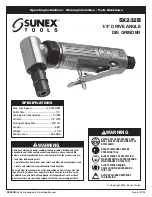
Instruction Manual
Section Five
a cut across the work. Steady movement is essential. When finish grinding,
reduce the traverse speed. Experience will tell the correct traverse for the
size and type of work.
G. The revolution of the work should not be stopped until the wheel has been
backed away from the work.
H. After the first cut is taken, the work should be measured for straightness and
machine setting. If the work is found to be larger at one end than at the
other, the table should be swiveled sufficiently away from the wheel at the
small end to correct the error.
I. All of the human senses may be utilized to advantage by the experienced
operator:
I. Watch the sparks. Much can be told about the progress of the work by
the sparks. When the work is turning slowly, any out-of-roundness will
manifest itself by intermittent sparking. If the work is irregular in
diameter at different points in its length, the condition will be shown by
changes in the amount of sparking. If the sparking has been regular and
suddenly becomes irregular, the fault may be that the work is over heating,
the centers are dry or loose, steady rests are out of adjustment, or the
wheel may have dirty or glazed spots.
2 Listen. Learn to use your ears for the informative sounds given off by the
wheel. Much can be determined by these sounds. During the truing and
dressing of a wheel, the sound will indicate if it is out-of-round. A
clicking sound might indicate a crack in the wheel. The note given off
by a running wheel changes as the wheel breaks down. A wheel which
is acting too hard gives off a note of high pitch, while one that is acting
too soft will chatter and break down frequently. When the wheel ap
proaches the work, it gives off a hissing sound which changes with its
relative proximity to the work. By close observation of the various sounds,
the operator may develop his judgement to a point where his efficiency is
greatly increased.
3. Feel. Use the sense of touch. An out-of-balance wheel will cause vi
bration The operator's sense of touch will discover this. Work finish
may be judged by touching the revolving work. Grit in the coolant may
be detected by feeling.
—81—
















































